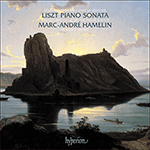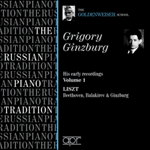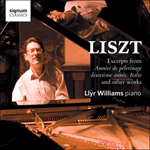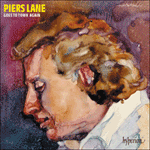
Welcome to Hyperion Records, a British classical label devoted to presenting high-quality recordings of music of all styles and from all periods from the twelfth century to the twenty-first.
Hyperion offers both CDs, and downloads in a number of formats. The site is also available in several languages.
Please use the dropdown buttons to set your preferred options, or use the checkbox to accept the defaults.

Gondoliera is described by Liszt in the score as La biondina in gondoletta—Canzone di Cavaliere Peruchini (Beethoven’s setting of it, WoO157/12, for voice and piano trio just describes it as a Venetian folk-song, and Peruchini remains elusive) and he treats it in a much gentler way than in the earlier version with a particularly fine verse with tremolo accompaniment; the tremolo guides a very dark musing upon Rossini’s Canzone del Gondoliere—‘Nessùn maggior dolore’ (Otello) which itself recalls Dante’s Inferno (‘There is no greater sorrow than to remember past happiness in time of misery’); and the Tarantella—incorporating themes by Guillaume Louis Cottrau (1797–1847)—emerges from the depths, much more subtle than in its previous, primary-coloured garb, but ultimately triumphantly boisterous.
from notes by Leslie Howard © 1997
Gondoliera, que Liszt décrit, dans sa partition, comme La biondina in gondoletta—Canzone di Cavaliere Peruchini (la mise en musique de Beethoven, WoO157/12, pour voix et trio avec piano, la présente juste comme une chanson populaire vénitienne, et Peruchini demeure un point évasif), est traitée de manière beaucoup plus douce que dans la version antérieure, avec un passage particulièrement beau, doté d’un accompagnement de trémolo; le trémolo guide une très sombre rêverie sur la Canzone del Gondoliere—«Nessùn maggior dolore» (Otello), laquelle rappelle l’Inferno de Dante («Il n’est de plus grande tristesse, à l’heure de la misère, que d’évoquer le bonheur passé»); quant à la Tarantella—qui incorpore des thèmes de Guillaume Louis Cottrau (1797–1847)—elle émerge des tréfonds, beaucoup plus subtile que dans sa mise antérieure, de couleur primaire, mais en définitive triomphalement pleine d’entrain.
extrait des notes rédigées par Leslie Howard © 1997
Français: Hypérion
Gondoliera wird von Liszt in der Partitur als La biondina in gondoletta—Canzone di Cavaliere Peruchini („Die blonde Dame in der Gondel—Lied des Kavaliers Peruchini“) beschrieben. (In Beethovens Vertonung, WoO157/12, für Gesang und Klaviertrio wird das Stück lediglich als ein venezianisches Volkslied beschrieben, und Peruchini bleibt ungenannt.) Das Stück wird hier einer wesentlich sanfteren Behandlung unterzogen als in der früheren Version, mit außerordentlich verfeinerten Versen und Tremolo-Begleitung. Das Tremolo flankiert einen finsteren Gedankenflug über Rossinis Canzone del Gondoliere—„Nessùn maggior dolore“ („Lied des Gondoliere aus Othello“), was in sich selbst an Dantes Inferno erinnert („Es gibt keinen größeren Schmerz, als die Erinnerung an vergangenes Glück in Zeiten der Not“). Die Tarantella, die Themen von Guillaume Louis Cottrau (1797–1847) enthält, steigt hier auf viel subtilere Weise als in ihrer vorherigen, grellen Version aus der Tiefe empor. Doch letztlich präsentiert sie sich mit ausgelassener Freude und triumphaler Miene.
aus dem Begleittext von Leslie Howard © 1997
Deutsch: Manuela Hübner
 Homages HomagesBenjamin Grosvenor's imaginative exploration of works by great composers paying tribute to their predecessors: Mendelssohn and Franck look back to the Prelude & Fugue form; Busoni presents Bach’s great solo violin Chaconne in a bold and imaginativ ...» More |
 Liszt: Complete Piano Music Liszt: Complete Piano MusicLeslie Howard’s recordings of Liszt’s complete piano music, on 99 CDs, is one of the monumental achievements in the history of recorded music. Remarkable as much for its musicological research and scholarly rigour as for Howard’s Herculean piano p ...» More |
 Liszt: Piano Sonata Liszt: Piano SonataThe Liszt Sonata is undoubtedly one of the peaks of the repertoire, and recordings are suitably copious, but when an artist of Hamelin’s virtuoso pedigree wishes to tackle it no excuse need be made for an additional version. This is a major Liszt ...» More |
 Grigory Ginzburg - His early recordings – 1 Grigory Ginzburg - His early recordings – 1'The Paganini etudes reveal a musician who marries precision with zest without taking any shortcuts pianistically; there is an honesty about his exalt ...» More |
 Louis Kentner – The pioneering Liszt recordings, Vol. 2 Louis Kentner – The pioneering Liszt recordings, Vol. 2'Excellently transferred from 78s dating from 1939-59, this selection ranges from Liszt’s early exuberance to the grim-faced austerity of his final ye ...  BBC Music Magazine» More BBC Music Magazine» More |
 Frederic Lamond - The complete Liszt recordings, HMV/Electrola 1919-36 Frederic Lamond - The complete Liszt recordings, HMV/Electrola 1919-36‘I suggest you look in this particular disc for something of Lamond’s greatness’ (MusicWeb International)» More |
 Liszt: Excerpts from Années de pèlerinage - Italie & other works Liszt: Excerpts from Années de pèlerinage - Italie & other worksPianist Llyr Williams, acclaimed soloist, accompanist and chamber musician chose to focus on virtuosic selections from Franz Liszt. Highly sought after as a performer in the United Kingdom, he was awarded a South Bank Sky Arts Award in 2012 for h ...» More |
 Piers Lane goes to town again Piers Lane goes to town againPiers Lane brings all his pianistic panache to this splendidly eclectic recital of works from the 1700s to the present day.» More |

